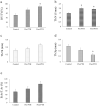Effects of pre-extraction intermittent PTH administration on extraction socket healing in bisphosphonate administered ovariectomized rats
- PMID: 33420145
- PMCID: PMC7794385
- DOI: 10.1038/s41598-020-79787-w
Effects of pre-extraction intermittent PTH administration on extraction socket healing in bisphosphonate administered ovariectomized rats
Abstract
The purpose of this study was to investigate the effect of administering intermittent parathyroid hormone (iPTH) before tooth extraction versus after tooth extraction on the risk of developing MRONJ in experimental animal model. Twenty-five ovariectomized rats received 6 weeks of bisphosphonate therapy. They were classified into 3 groups, based on the timing of the medication, as Control, Pre-PTH and Post-PTH groups. For Control group, normal saline was administered before and after tooth extraction. iPTH was administered during 4 weeks before tooth extraction for Pre-PTH group and after tooth extraction for Post-PTH group. The animals were euthanized 8 weeks after tooth extraction. Macroscopic, histological, micro-computed tomography (micro-CT), and histomorphometric examinations were conducted. The incidences of impaired healing were 11.11% both in Pre-PTH and Post-PTH groups, which was lower than the Control group (42.86%). Bone healing in the extraction socket, based on micro-CT and histomorphometry evaluations, was best in Post-PTH and worst in Control group. The Pre-PTH group showed moderate healing pattern. Despite of limitations in this study, the authors identified Pre-PTH group seems to have positive effect on extraction socket healing. With regard to timing, administering iPTH after tooth extraction was superior to applying it before tooth extraction.
Conflict of interest statement
The authors declare no competing interests.
Figures




Similar articles
-
The effects of intro-oral parathyroid hormone on the healing of tooth extraction socket: an experimental study on hyperglycemic rats.J Appl Oral Sci. 2020;28:e20190690. doi: 10.1590/1678-7757-2019-0690. Epub 2020 Apr 27. J Appl Oral Sci. 2020. PMID: 32348445 Free PMC article.
-
Distinctive tooth-extraction socket healing: bisphosphonate versus parathyroid hormone therapy.J Periodontol. 2014 Jan;85(1):24-33. doi: 10.1902/jop.2013.130094. Epub 2013 May 20. J Periodontol. 2014. PMID: 23688101 Free PMC article.
-
Early effects of parathyroid hormone on bisphosphonate/steroid-associated compromised osseous wound healing.Osteoporos Int. 2014 Mar;25(3):1141-50. doi: 10.1007/s00198-013-2570-8. Epub 2013 Dec 4. Osteoporos Int. 2014. PMID: 24301537 Free PMC article.
-
The effects of sodium alendronate on socket healing after tooth extraction: a systematic review of animal studies.Braz Oral Res. 2024 May 13;38:e038. doi: 10.1590/1807-3107bor-2024.vol38.0038. eCollection 2024. Braz Oral Res. 2024. PMID: 38747825 Free PMC article.
-
Biomaterials and therapeutic strategies designed for tooth extraction socket healing.Biomaterials. 2025 May;316:122975. doi: 10.1016/j.biomaterials.2024.122975. Epub 2024 Nov 29. Biomaterials. 2025. PMID: 39626339 Review.
Cited by
-
Bisphosphonate-incorporated coatings for orthopedic implants functionalization.Mater Today Bio. 2023 Jul 22;22:100737. doi: 10.1016/j.mtbio.2023.100737. eCollection 2023 Oct. Mater Today Bio. 2023. PMID: 37576870 Free PMC article. Review.
-
Medication-related osteonecrosis of the jaw: evolving research for multimodality medical management.Support Care Cancer. 2024 Mar 5;32(4):212. doi: 10.1007/s00520-024-08388-4. Support Care Cancer. 2024. PMID: 38443685 Review.
-
Rat Calvaria Model Mimicking the Intraoral Lesion of Medication-Related Osteonecrosis in the Jaw: A Preliminary Test.J Clin Med. 2023 Oct 25;12(21):6731. doi: 10.3390/jcm12216731. J Clin Med. 2023. PMID: 37959197 Free PMC article.
-
Preventive effect of teriparatide on medication-related osteonecrosis of the jaw in rats.Sci Rep. 2023 Sep 19;13(1):15518. doi: 10.1038/s41598-023-42607-y. Sci Rep. 2023. PMID: 37726385 Free PMC article.
-
Selenium-modified calcium phosphate cement can accelerate bone regeneration of osteoporotic bone defect.J Bone Miner Metab. 2021 Nov;39(6):934-943. doi: 10.1007/s00774-021-01240-3. Epub 2021 Jun 29. J Bone Miner Metab. 2021. PMID: 34189659
References
-
- Damm DD, Jones DM. Bisphosphonate-related osteonecrosis of the jaws: A potential alternative to drug holidays. Gen. Dent. 2013;61:33–38. - PubMed
MeSH terms
Substances
LinkOut - more resources
Full Text Sources
Other Literature Sources

